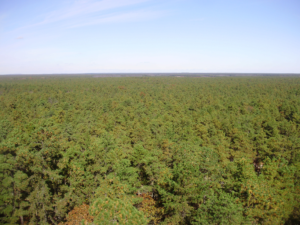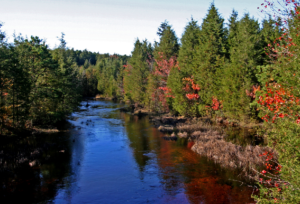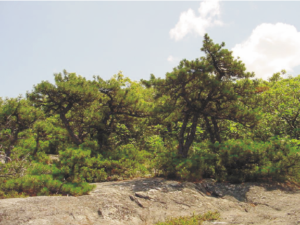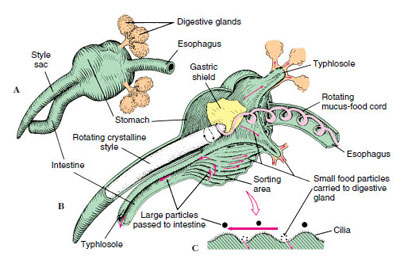
Barnegat Bay Environment
The Watershed
The Pine Barrens
The New Jersey Pine Barrens, also known as the Pinelands or simply the Pines, is the largest remaining example of the Atlantic coastal pine barrens ecosystem, stretching across more than seven counties of New Jersey.
 There is a difference
There is a difference
The Pine Barrens (shaded in orange-purple) is an ecological term that is used to described habitats that are comprised of sandy nutrient poor soils, acidic water and soil and fire adapted plant communities.
The Pinelands (located within the Pine Barrens – shaded in green) is a political term that describes the 1.1 million acres in south Jersey that is subject to the Pinelands Comprehensive Management Plan.
 Pine Barrens
Pine Barrens
One of the most distinctive characteristics of the Pine Barrens, are its surface water bodies of streams, rivers and wetlands.
The streams are typically slow moving and shallow because of the very low topographic gradient, or relief, of the Outer Coastal Plain of New Jersey.
Habitat
Pine/Oak Upland Forest is the most common and the most characteristic natural community in the Pine Barrens.
The majority of the canopy trees are Pitch Pines, the most characteristic tree of the Pine Barrens, with a smaller number of Shortleaf Pines, and, in some areas, a few Virginia Pines.
 Pygmy Pine Plains
Pygmy Pine Plains
The Pygmy Pine Plains (or Dwarf Plains) of the Pine Barrens are upland forests contains trees that may attain a height of only about four feet at maturity.
The Pine Plains soils are particularly droughty and nutrient-poor, and, as plateaus elevated above their surroundings, the plains are subject to higher winds. Most importantly, for centuries these forests have been exposed to wildfires at least twice as frequently as other Pine Barrens forests.
In environments where hot, fast moving fires are frequent, some pine species have developed very thick, hard cones that are literally glued shut with a strong resin.
These “serotinous” cones can hang on a pine tree for years, long after the enclosed seeds mature. Only when a fire sweeps through, melting the resin, do these heat-dependent cones open up, releasing seeds that are then distributed by wind and gravity.
Fun Fact – The Pine Barrens have sandy, acidic soil considered unsuitable for traditional farming by early settlers, who called the land “barren”.
The Pinelands
The 1.1-million-acre Pinelands Natural Reserve stretches south and west from northern Ocean County and makes up 22 percent of New Jersey’s total land mass.
Created by Congress in 1978, the reserve was designated an International Biosphere Reserve in 1988. It’s bigger than either Yosemite or Grand Canyon national park,
In 1995, the Barnegat Bay, located along the eastern portion of the Pinelands National Reserve, was accepted into the National Estuary Program by the U.S. Environmental Protection Agency (EPA)
The Pinelands encompasses most, but not all of the Pine Barrens ecosystem.
Kirkwood-Cohansey aquifer
A vast underground reservoir containing some 17 trillion gallons of fresh water in southern New Jersey and covers approximately 3,ooo square miles.
It is a shallow, unconfined or “water table” aquifer meaning that the water in the ground is just below the land’s surface in most areas.
The Kirkwood–Cohansey aquifer consists of two geologic units.
The Cohansey formation, above, consists mostly of sand, while the Kirkwood formation, below contains both silt and clay.
This structure creates a water-confining layer below the aquifer while allowing the top layer of water-bearing sands to remain hydrologically connected to surface water.
Pitch Pine Pinus rigida
 Pitch pine is the most abundant tree species in the most frequently and intensely burned parts of the New Jersey Pine Barrens.
Pitch pine is the most abundant tree species in the most frequently and intensely burned parts of the New Jersey Pine Barrens.
Pitch Pine prefers nutrient-poor, dry, sandy soils, and will grow where other trees cannot.
Pitch pines are monoecious (both male and female cones are produced on the same plant).
Male cones produce pollen in the spring, are often abundant on low branches.
Female cones, which will ultimately produce seeds, are more common on upper branches. A percentage of a pitch pine cones are serotinous and remain closed until the heat of a fire melts the resinous glue that holds the scales of the cone together. Only then are the seeds released.
A percentage of a pitch pine cones are serotinous and remain closed until the heat of a fire melts the resinous glue that holds the scales of the cone together. Only then are the seeds released.
Pitch pine is one of the most fire resilient eastern conifers. Where fire kills the foliage, new needles are produced on new branches from suppressed buds on the bole. This adaptation allows for survival in a high frequency fire area such as the Pine Barrens.
Fire adaptations: Pitch pine has numerous fire adaptations that allow it to establish and/or regenerate on burned sites.
 Fun Fact – A cluster of pine needles is called a fascicle. Pitch pine has 3 needles per fascicle often compared to a “pitchfork”
Fun Fact – A cluster of pine needles is called a fascicle. Pitch pine has 3 needles per fascicle often compared to a “pitchfork”
Credits
Aquifer image – Krishna Mathias – Atlantic City Press
tree-guide.com
Pitch pine releasing seeds – John M. Burnley / Science Source
